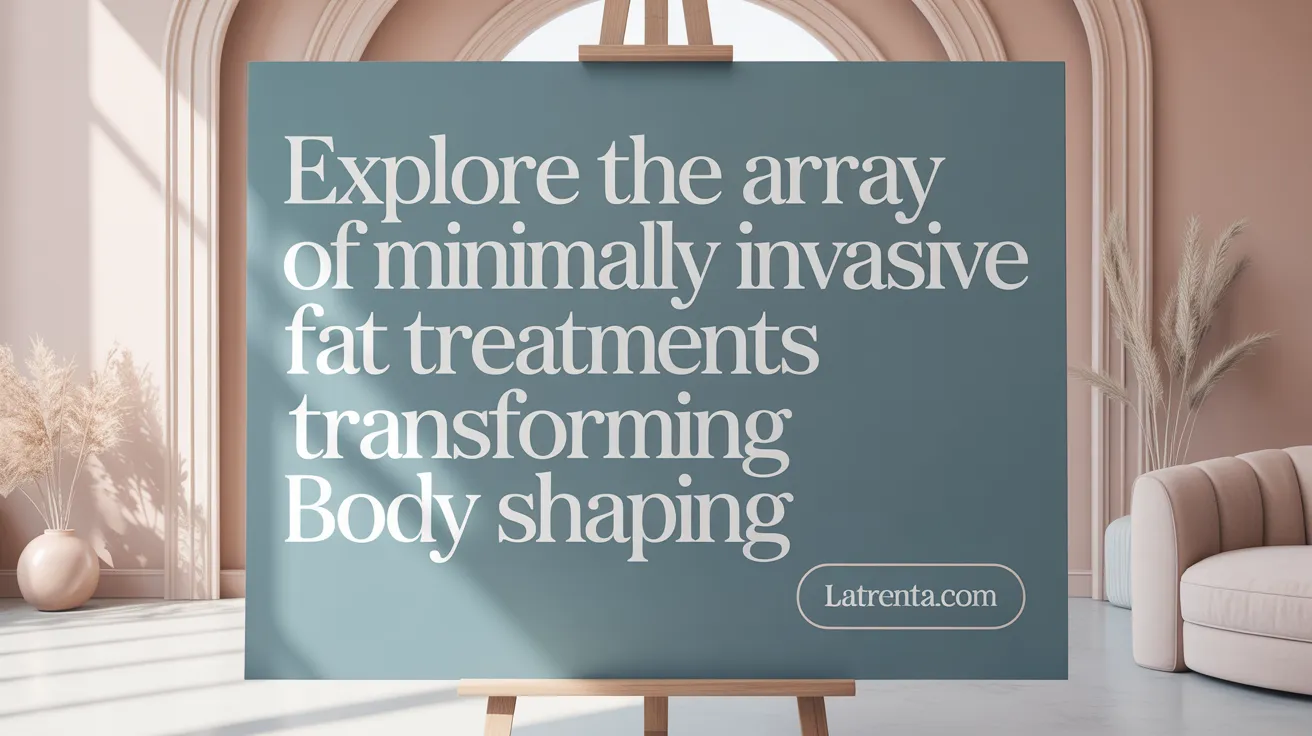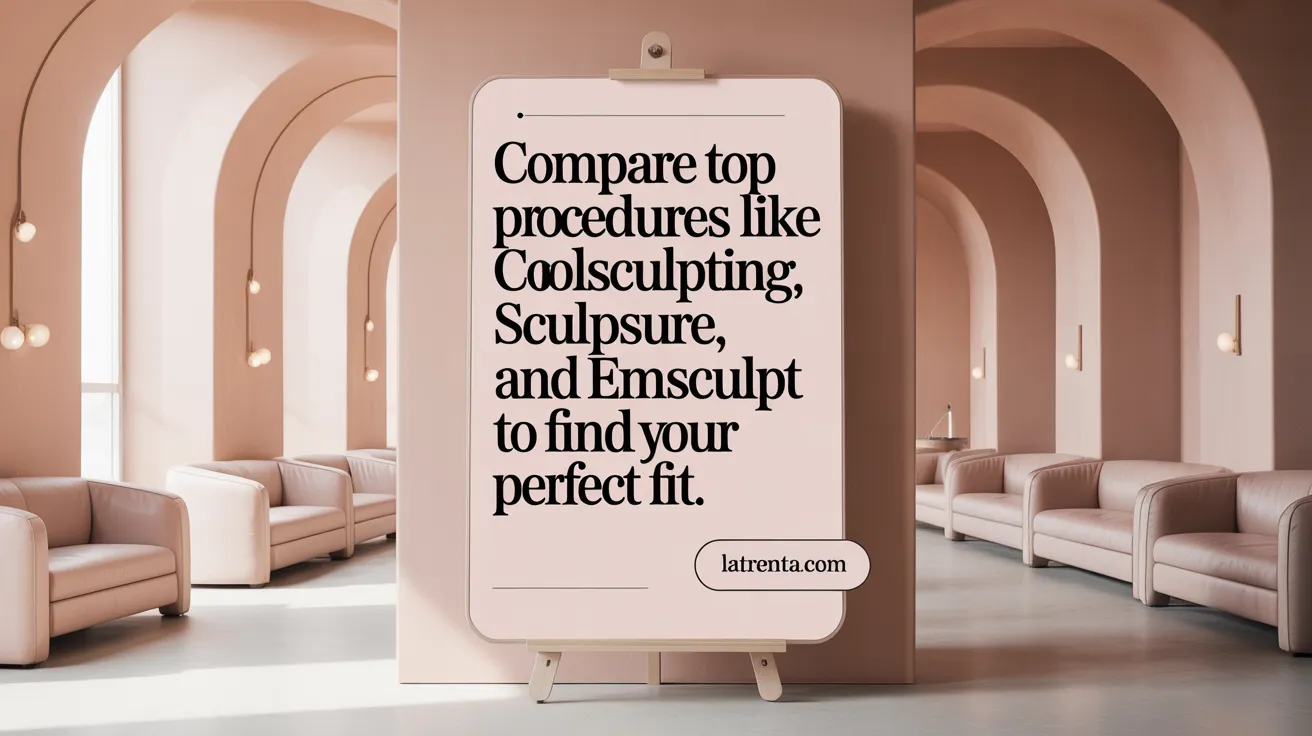Unlocking the Potential of Non-Surgical Body Contouring
In the quest for a toned and sculpted physique, body contouring has emerged as a popular solution for those looking to refine their shape without undergoing surgery. Modern non-surgical body contouring methods offer effective alternatives to traditional procedures like liposuction and tummy tucks. These innovative techniques harness advanced technologies such as controlled cooling, laser heat, ultrasound, and electromagnetic energy to target stubborn fat and improve muscle tone, all with minimal downtime. This article dives deep into the array of non-invasive body sculpting options, their mechanisms, benefits, safety, and how they compare with surgical approaches to help you make informed decisions on your body shaping journey.
Understanding Non-Surgical Body Contouring: Technologies and Methods

What are the common non-surgical body contouring options, methods, and technologies available?
Non-surgical body contouring offers a variety of minimally invasive fat treatments designed to reduce localized fat, tighten skin, and improve body shape without surgery. Popular techniques include cryolipolysis (CoolSculpting), laser lipolysis (such as SculpSure), ultrasound fat reduction, radiofrequency treatments, and injectable deoxycholic acid (Kybella). For example, cryolipolysis like CoolSculpting uses controlled cooling to freeze and destroy fat cells, which are then naturally eliminated by the body. Laser technologies such as SculpSure employ targeted heat to break down fat cells, while ultrasound treatments like UltraShape use focused sound waves for fat cell disruption. Radiofrequency devices, including Thermage and Exilis, generate thermal energy to tighten skin and reduce fat. Injectables like Kybella contain deoxycholic acid, which chemically destroys fat cells, particularly in the submental area. Additionally, muscle toning and skin tightening can be achieved through electromagnetic stimulation devices like EmSculpt, which induce involuntary muscle contractions. Most of these treatments require little to no downtime and are used mainly for body contouring, rather than weight loss or obesity management.
What are the mechanisms of action and technologies behind non-invasive fat reduction treatments?
Non-invasive fat reduction treatments work through various mechanisms that target fat cells or stimulate collagen and skin tightening. Cryolipolysis, for instance, leverages the fact that fat cells are more susceptible to cold; by applying controlled cooling, it induces apoptosis (programmed cell death) in adipocytes without harming surrounding tissues. The body then gradually clears these destroyed fat cells via natural processes, leading to a reduction in fat pocket volume.
Heat-based technologies, such as radiofrequency (RF), laser, and high-intensity focused ultrasound (HIFU), deliver thermal energy to fat tissue, raising the temperature to levels that cause cell damage and necrosis. RF devices typically heat tissues to around 42-45°C, stimulating collagen production for skin tightening, while laser devices like SculpSure use specific wavelengths to precisely target and dismantle adipocytes.
Ultrasound treatments employ focused sound waves to penetrate deep layers and rupture fat cell membranes, resulting in fat reduction. Some modalities, like low-level laser therapy, trigger fat cell membrane disruption through light energy absorption, which prompts the cells to release their contents.
Collectively, these mechanisms allow for safe, effective fat reduction and skin tightening with minimal discomfort and no need for surgery. They work by selectively damaging adipocytes or stimulating the body's natural processes to remove fat, making these treatments suitable for patients seeking body shaping with little to no recovery time.
Benefits and Advantages of Non-Invasive Body Shaping Procedures
 Non-invasive body shaping procedures offer several advantages over surgical options, including minimal or no downtime, reduced risk of complications, and the absence of general anesthesia, making them more accessible and convenient for patients.
Non-invasive body shaping procedures offer several advantages over surgical options, including minimal or no downtime, reduced risk of complications, and the absence of general anesthesia, making them more accessible and convenient for patients.
These techniques typically involve less discomfort, fewer side effects such as scarring or infections, and can be performed in outpatient settings, often allowing patients to resume daily activities immediately after treatment.
While surgical procedures, such as liposuction or body lifts, tend to provide more immediate and dramatic fat removal, non-invasive methods gradually enhance body contours through multiple sessions, resulting in subtle yet noticeable improvements over weeks or months.
Results from non-invasive fat reduction treatments are generally long-lasting as the fat cells destroyed do not regenerate, especially when combined with healthy lifestyle habits like proper diet and exercise.
These procedures are particularly suitable for individuals who are close to their ideal weight but wish to target specific stubborn fat deposits resistant to traditional methods.
Overall, non-surgical body shaping offers a safer, less intrusive alternative that emphasizes safety, comfort, and gradual, natural-looking results, making it an increasingly popular choice among those seeking modest body enhancements without the risks and recovery time associated with surgery.
Comparing Non-Surgical and Surgical Body Contouring Techniques
How do non-surgical body contouring techniques differ from surgical ones?
Non-surgical body contouring methods are designed to reshape the body without incisions, anesthesia, or significant downtime. These procedures include cryolipolysis (fat freezing), laser lipolysis (such as SculpSure), radiofrequency treatments, and injectable deoxycholic acid (Kybella). They work by targeting fat cells externally, employing controlled cold, heat, or chemical destruction to gradually reduce local fat deposits.
In contrast, surgical techniques like liposuction, tummy tucks, and body lifts involve making incisions, administering anesthesia, and physically removing or reshaping fat and skin. Surgical procedures typically provide more immediate, dramatic results and are suitable for larger volume fat removal or significant skin tightening.
Recovery periods greatly differ. Non-invasive treatments usually require little to no recovery time; patients can often return to normal activities immediately after sessions. Conversely, surgical procedures involve longer healing periods, often requiring weeks of activity restriction, compression garments, and follow-up care.
Risks are also different. Surgical options carry higher risks such as bleeding, infection, nerve damage, and scarring. Non-surgical procedures tend to have milder side effects like temporary swelling, redness, or bruising. When choosing between the two, patients should consider their desired outcomes, tolerance for recovery, and risk appetite.
Overall, non-surgical body contouring offers a safe, less invasive alternative suitable for moderate fat reduction and body reshaping. Surgical options remain more effective for larger volume removal and more immediate results, but involve greater risks and longer recovery.
Deep Dive into Popular Non-Invasive Procedures: CoolSculpting, EmSculpt, SculpSure, and More
 Non-invasive procedures for body contouring have become increasingly popular as safe, effective alternatives to surgical methods. Common treatments include CoolSculpting, SculpSure, EmSculpt, UltraShape, Liposonix, and UltraSlim, each utilizing different technologies to target fat or build muscle without surgery.
Non-invasive procedures for body contouring have become increasingly popular as safe, effective alternatives to surgical methods. Common treatments include CoolSculpting, SculpSure, EmSculpt, UltraShape, Liposonix, and UltraSlim, each utilizing different technologies to target fat or build muscle without surgery.
CoolSculpting, for instance, employs cryolipolysis—using controlled cooling to freeze and destroy fat cells. It is FDA-cleared for areas such as the abdomen, thighs, chin, and flanks. During a typical session, the device applies paddles to the targeted area, and patients often describe the sensation as a cold massage. Results usually appear gradually over 1 to 3 months, with fat reduction of up to 25% per area.
SculpSure takes a different approach by using laser heat at a wavelength that heats and melts fat cells. This treatment is quick, painless, and usually lasts about 25 minutes. It is FDA-cleared for the abdomen and flanks, with noticeable results within 6 to 12 weeks. It also stimulates collagen production, potentially improving skin firmness.
EmSculpt combines high-intensity focused electromagnetic (HIFEM) energy—stimulating around 20,000 muscle contractions in a 30-minute session—to enhance muscle tone and composition. It is effective for the abdomen and buttocks, with results including increased muscle mass and fat reduction, typically visible at around 4 weeks, with full effects observable by 12 weeks.
Ultrasound-based treatments like UltraShape and Liposonix utilize sonic waves to break down fat in targeted areas, such as the abdomen and thighs. These procedures are FDA-cleared, require no downtime, and results are seen gradually over 6 to 12 weeks.
Red light therapy, exemplified by UltraSlim, uses specific wavelengths of light to trigger fat cells to release their contents, leading to fat cell shrinkage. This rapid treatment begins showing results within hours and is often performed in a series of sessions.
Each of these treatments offers a minimally invasive way to enhance body contour, with generally mild side effects like temporary redness, swelling, or numbness. They are suitable for individuals seeking modest fat reduction or muscle toning as part of a broader healthy lifestyle. Consulting a qualified healthcare provider ensures choosing the most suitable option tailored to personal goals and health considerations.
Expected Results, Recovery, and Safety of Non-Surgical Body Contouring
 Non-surgical body contouring treatments, such as cryolipolysis (CoolSculpting), radiofrequency, laser lipolysis, and injection lipolysis, typically produce gradual fat reduction and muscle toning over weeks to months. Most patients notice modest improvements in their body shape within about 6 to 12 weeks, with many treatments showing optimal results around this time. Unlike surgical procedures, these treatments usually do not cause significant swelling or long-term discomfort, allowing individuals to resume their normal activities immediately after the session. This minimal recovery time is one of the main advantages of non-invasive methods.
Non-surgical body contouring treatments, such as cryolipolysis (CoolSculpting), radiofrequency, laser lipolysis, and injection lipolysis, typically produce gradual fat reduction and muscle toning over weeks to months. Most patients notice modest improvements in their body shape within about 6 to 12 weeks, with many treatments showing optimal results around this time. Unlike surgical procedures, these treatments usually do not cause significant swelling or long-term discomfort, allowing individuals to resume their normal activities immediately after the session. This minimal recovery time is one of the main advantages of non-invasive methods.
Common temporary side effects include redness, swelling, bruising, numbness, tingling, warmth, or mild discomfort at the treatment site. These effects generally resolve within a few days to a week. It’s important to note that while results are healing and noticeable, they are typically subtle and milder compared to surgical options, which can deliver more immediate and drastic changes.
Safety considerations depend on choosing a qualified provider with experience in performing these treatments. When performed correctly, non-surgical body contouring has a very low risk of serious complications. Nonetheless, individuals should disclose their full medical history and adhere to pre- and post-treatment instructions.
In summary, non-invasive body contouring offers a safe and effective way to improve body shape with minimal downtime and mild, temporary side effects. Its gradual results and low risk make it a popular option for those seeking subtle, natural-looking improvements without surgery.
Choosing the Right Non-Invasive Body Shaping Option
 When selecting a non-invasive body shaping treatment, individuals should carefully consider multiple factors to ensure the procedure aligns with their goals and needs.
When selecting a non-invasive body shaping treatment, individuals should carefully consider multiple factors to ensure the procedure aligns with their goals and needs.
First, define your specific treatment objectives, such as reducing stubborn fat, tightening skin, or building muscle tone. Different procedures target these concerns differently, so understanding what each method offers is essential.
Next, evaluate the target areas you wish to improve. Some treatments are more effective for certain regions, such as the abdomen, thighs, or chin, while others may have broader applications.
Assess the expected results and how quickly you want to see them. Procedures like cryolipolysis (CoolSculpting) typically show results within 1 to 3 months, whereas red light therapy may produce subtle changes within hours.
The number of sessions needed varies based on the treatment and desired outcome. Some technologies require multiple visits for optimal results, which can influence your scheduling and budget.
Downtime and recovery are important considerations. Most non-invasive options offer minimal to no downtime, making them convenient for busy lifestyles.
Safety profiles and potential risks depend on individual health conditions. Consulting with a qualified healthcare provider ensures that the selected procedure is safe for your unique medical history.
Cost is another factor; treatments differ in price and long-term maintenance. While non-invasive procedures tend to be less costly than surgery, they still require investment, especially if multiple sessions are necessary.
Finally, choosing an experienced provider is critical. Providers with specialized training and certification can perform these procedures safely and effectively, optimizing results and minimizing complications.
In summary, understanding treatment goals, assessing safety and provider expertise, considering financial aspects, and setting realistic expectations are all vital steps in selecting the most appropriate non-invasive body shaping option.
Biological Basis and Comparative Efficacy of Non-Surgical Fat Reduction Treatments
How does non-surgical fat reduction work biologically to reduce fat?
Non-surgical fat reduction treatments operate by selectively damaging fat cells, known as adipocytes, through various energy modalities. One common method, cryolipolysis (CoolSculpting), employs controlled cooling to induce apoptosis, or programmed cell death, specifically in fat cells that are more sensitive to cold than surrounding tissues. This process causes fat cells to break down and be gradually eliminated by the lymphatic system over weeks.
In addition to cryolipolysis, other techniques such as radiofrequency (RF) and high-intensity focused ultrasound (HIFU) deliver heat or focused sound waves respectively, which disrupt the fat cell membranes, induce coagulation, and rupture the cells. These damaged fat cells also undergo natural removal by the body's metabolic pathways.
Some of the newer approaches aim to stimulate thermogenic fat activity, such as beige or brown adipose tissue, which increases energy expenditure and accelerates fat breakdown. These methods are still under research but represent an exciting frontier in non-invasive body contouring.
Overall, these treatments aim to destroy or weaken fat cells in targeted areas, leading to a reduction in subcutaneous fat layers that can improve body contours.
Comparison of technologies and clinical efficacy
Different non-invasive fat reduction technologies vary in their mechanisms, results, and patient experiences. For example, cryolipolysis (CoolSculpting) typically achieves about 20-25% fat reduction in treated areas after one or more sessions, with noticeable results appearing within 1 to 3 months. It is FDA-cleared and widely studied, with high patient satisfaction.
Laser-based systems like SculpSure use controlled heat via laser energy to destroy fat cells in about 25-minute sessions. Results become visible in around 6 weeks, with an average fat reduction of approximately 24%. This method tends to be comfortable and well-tolerated.
Electromagnetic devices such as EMSCULPT and truSculpt employ high-intensity focused electromagnetic energy or radiofrequency to induce muscle contractions or heat fats, respectively. EMSCULPT, combining muscle building and fat reduction, claims to increase muscle mass by about 16% and decrease fat by 15%, with results visible after a few treatments.
Other approaches, including radiofrequency or ultrasound, generally require multiple sessions and have minimal side effects like redness, swelling, or discomfort. The choice of technology depends on treatment goals, target areas, and patient preferences.
Treatment experience and patient considerations
Most non-surgical treatments are designed to be quick and convenient, often lasting less than 45 minutes per session, with minimal discomfort or downtime. Many patients describe sensations such as cold, warmth, or tingling during procedures.
Common side effects are temporary and include redness, swelling, bruising, or numbness, which resolve within hours to days. For example, CoolSculpting might cause mild pain or numbness, whereas laser treatments like SculpSure may cause a warming sensation.
Patients should have realistic expectations: these procedures are primarily for shaping and reducing small to moderate fat pockets resistant to diet and exercise. They are not effective for significant weight loss or obesity, and maintaining results requires a healthy lifestyle.
Choosing a qualified provider is essential to ensure safety and optimal results. The ideal candidate is close to their ideal weight and has localized fat deposits. Treatment plans vary based on individual anatomy, desired outcomes, and tolerance for procedures.
In summary, non-surgical fat reduction offers safe, effective options for improving body contours with minimal invasion. The technology continues to evolve, promising greater efficacy and comfort for patients seeking non-invasive body sculpting.
Embracing Non-Surgical Body Contouring for a Confident You
Non-surgical body contouring has transformed the landscape of aesthetic medicine, offering safe, effective, and convenient options for individuals seeking to sculpt their bodies without the risks and recovery times associated with surgery. By understanding the diverse technologies, mechanisms, benefits, and limitations of treatments like CoolSculpting, EmSculpt, SculpSure, and others, patients can make informed decisions aligned with their unique goals and lifestyles. With minimal downtime, gradual yet lasting results, and a focus on health maintenance, these non-invasive procedures serve as valuable tools for enhancing body confidence and contour. Consultation with experienced and qualified providers remains essential to optimize outcomes and ensure safety. As non-surgical body contouring continues to evolve, it promises to further empower individuals on their journey toward their desired physique, providing sculpting without surgery.
